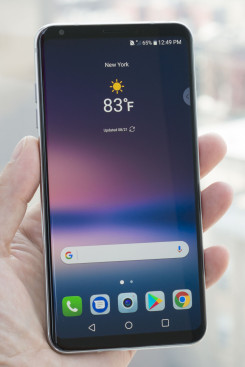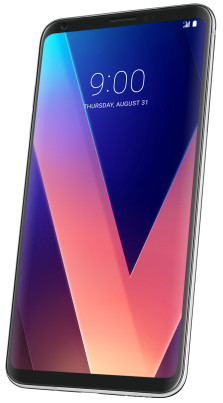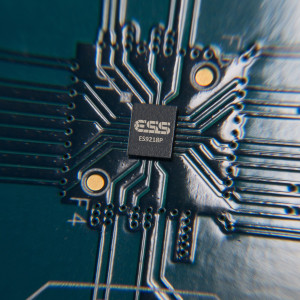IFA 2017
IFA is Europe's big annual gadget show, and it increasingly plays host for new phone announcements. We're expecting news from LG, Samsung, Sony, Motorola, Huawei, and more. We're in Berlin all week bringing you in-depth hands-on reports.

Hands On with the LG V30
The V30 is LG's new top-end flagship, for people who want something even more cutting-edge than the G6. As with previous V-series phones, it sports a huge screen. But the incredibly tiny bezels let LG make the screen much larger, but the phone much smaller, compared to last year's V20. LG has taken all of the features of the G6 and improved them, including a better dual-camera setup, faster processor, and OLED screen capable of VR. The V series continues to support advanced audio, but the V30 adds advanced video features as well, including a feature similar to RAW mode for video. We spent some time with the V30; read on for our first impressions.

LG Announces the V30 Flagship with FullVision Display and Floating Info Bar
LG today fully revealed the V30, a phone it has been teasing in bits and pieces over the last few weeks. This flagship-class handset has a metal frame and glass front and rear panels. The V30 does away with the secondary display that adorned the front of the V10 and V20. In its place, LG created what it calls the Floating Bar, a semi-transparent strip that gives V30 owners access to frequently used functions, such as contacts and settings. The phone is among the first to use a plastic OLED FullVision display, though it is protected by Gorilla Glass 5. The 6-inch panel has 2,880 by 1,440 pixels, or a 2:1 (18:9) aspect ratio, and nearly non-existent side bezels. LG reduced the phone's upper and lower bezels by 20% and 50%, respectively, when compared to the V20. The phone makes use of an f/1.6 aperture camera at 16 megapixels, a first according to LG. The f/1.6 lens allows 25% more light to reach the sensor when compared to an f/1.8 lens. Further, LG is adopting what it calls a Crystal Clear Lens that's made of glass, rather than plastic. The glass permits more light to travel through it, while also allowing for better color reproduction. Like the V20 and G6, the V30 has a dual camera array with one wide-angle lens and one standard-angle lens with optical image stabilization, laser autofocus, and electronic image stabilization. The secondary lens has a 13-megapixel resolution at f/1.9 and 120-degree field of view. The phone has a Qualcomm Snapdragon 835 processor at its core with 4 GB of memory and 64 GB of storage (the V30+ jumps to 128 GB of storage). Other specs include a 3,400mAh battery with wireless charging and an IP68 rating for protection from water and dust. The Always On Display is more customizable than before and includes shortcuts to Quick Tools, the music player, and even photos. Additional software features baked into LG UX 6.0 include Face Recognition that LG says unlocks the phone instantly even when the display is off. Voice Recognition now uses a combination of the user's voice and self-generated keywords to unlock the phone without any button presses. The V30's camera gains access to Graphy, a tool for applying professional-looking styles to photos and V30 owners will be able to create GIFs or movies by pasting together photos and/or video files. Last, LG said the V30 adopts a 32-bit advanced hi-fi quad DAC from ESS Technology, which reproduces music as close to the original source as possible. It includes high-resolution audio streaming thanks to technology from MQA Ltd. On the recording front, the V30's HD Audio Recorder can use the handset's audio receiver as a microphone. LG says this lets the phone record a wider dynamic range of sound, "from a whisper to a thunderstorm," without distortion. The LG V30 will go on sale in Korea starting September 21 with other markets, including North America, to follow soon thereafter. Pricing was not immediately disclosed.

LG Promises the V30 Will 'Delight Ears Everywhere' with New Hi-Fi Powers
LG today said its forthcoming V30 flagship handset will be its most advanced device yet when it comes to audio reproduction and recording. To start, the phone adopts a 32-bit advanced hi-fi quad DAC from ESS Technology. It builds on LG's original hi-fi quad DAC, which reproduces music as close to the original source as possible. The ESS Sabre ES9218P audio processor introduces digital filters and sound presets. According to LG, the digital filters improve the pre- and post-ringing of the impulse response in such a way that they can be easily customized by end users. This works hand in hand with the new pre-programmed presets (enhanced, detailed, live, and bass), allowing even inexpensive headphones to reproduce high-quality music. Moreover, the hi-fi quad DAC manages the left and right audio signals separately, dynamically adjusting balance to ensure listeners remain centered. The new DAC cuts the distortion rate down to 0.0002%, meaning it reproduces the cleanest and most accurate signal possible. Last, the V30 introduces high-resolution audio streaming thanks to technology from MQA Ltd. LG says its advanced hi-fi quad DAC and MQA tech will work together to bring the best sound to music streamed from sources such as Spotify and Google Play Music. On the recording front, the V30's HD Audio Recorder can use the handset's audio receiver as a microphone (Receiver-as-a-Mic or RAM). LG says this lets the phone record a wider dynamic range of sound, "from a whisper to a thunderstorm," without distortion. LG is expected to announce the V30 on August 31 during the IFA trade show in Berlin.









